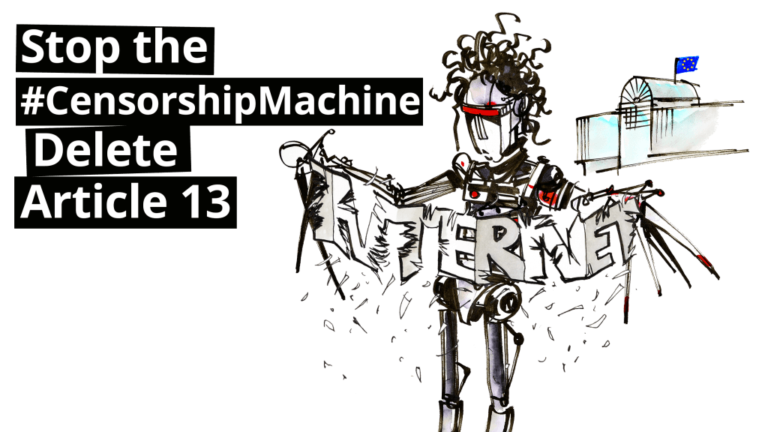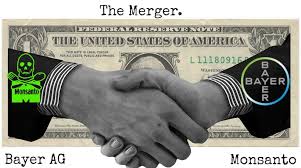Scientific review of pesticide cancer risk ignites war against scientists
“Monsanto [is] a company so widely detested that a week rarely passes without at least one protest against its power and its products occurring somewhere in the world.” (Vandana Shiva)
When asked about the points of criticism of his company’s aggressive marketing of toxic pesticides/ herbicides (Roundup) and genetically engineered/modified (GE, GM,GMO) seeds (Roundup Ready), Monsanto’s chairman of the board, Hugh Grant responded: “We are a science-based company. I feel very strongly that you need to be grounded in the science or you lose the drift.” ( The New Yorker, 2014) That claim — “grounded in the science” — is propaganda. The problem with that claim is that most genetically modified organisms (GMOs) have not been subjected to a scientifically valid test for safety.
The fact is that GMOs entered into the US food supply in 1996 without safety tests, without fanfare and without public discussion. Few Americans, including scientists and doctors knew anything about GMOs until the documentary “Food Inc” was aired in 2008. Europeans and Asians by contrast, knew about some of the shortcomings of GMO industrial technology, and were concerned about the long-term consequences. European countries, India, and other nations either banned GM food under the precautionary principle or placed restrictions on their production.
Americans became unwitting human subjects of a vast uncontrolled experiment.
Because GMOs had evaded mandatory safety tests, the sole legal basis for their approval in the U.S. was the claim that there an overwhelming consensus exists among scientists about their safety. That claim is an outright lie inasmuch as GMOs and the pesticides that are the linchpin of the industry, are at the center of an ongoing, extremely acrimonious debate within the scientific community. Indeed, a growing body of peer-reviewed scientific evidence belies assurances Americans are given, that our exposure to ever increasing levels of pesticides in the environment and in the food we consume is perfectly safe.
Alarms went off in March 2015 when a review by the International Agency for Research on Cancer (IARC), an intergovernmental independent agency within the World Health Organization which concluded that the available evidence was sufficient to classify glyphosate as “probably carcinogenic to humans.” The IARC evaluations are made by Working Groups composed of leading independent cancer specialists; in this instance, 17 specialists from 11 countries. They reached the determination after reviewing all the untainted published scientific evidence, as well as government reports.
The evidence recorded by independent scientists who are not under the thumb of the biotech agriculture industry, shows that glyphosate may cause harm even at very low levels. The glyphosate levels that the human population is routinely exposed to in the US has vastly increased with the increased production and consumption of genetically engineered / modified (GE, GM, GMO) foods. Glyphosate is the most widely used pesticide and herbicide in the world. Even non-GM crops have been sprayed with glyphosate as a pre-harvest drying agent.
“Glyphosate is the billion-dollar-baby, the chief ingredient in Monsanto’s branded Roundup herbicide as well as in hundreds of other herbicides sold around the world. It’s also the lynchpin to Monsanto’s top-selling, glyphosate-tolerant, genetically engineered crops.” (Right to Know)
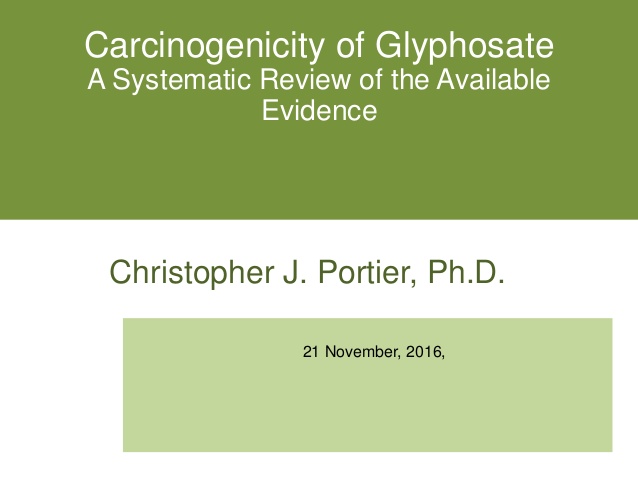 Human exposure & toxicity of glyphosate has never been properly tested
Human exposure & toxicity of glyphosate has never been properly tested
The toxicity of glyphosate has never been studied at levels that the human population in the U.S. is being exposed to on a daily basis. Recent laboratory tests found glyphosate in human urine, blood and breast milk; raising increased concerns among scientists and informed citizens about the weed killer’s toxicity and its potential health hazards. Despite troubling signals and findings in multiple scientific studies over the decades, suggesting its harmful impacts, U.S. regulatory agencies, aligned with the biotech agriculture industry, have simply denied that a problem exists.
US regulatory agencies continue to accept industry’s preferred outdated risk and exposure evaluation standards: only high-dose exposure, 90 day studies in animals are used to determine “safe” exposure levels. For decades Monsanto publicly declared that glyphosate, the primary ingredient in its herbicide, Roundup, was perfectly safe –“safer than table salt” and “practically non-toxic.” A French court found Monsanto guilty of false advertising and a lawsuit by New York State Attorney General ordered Monsanto to “cease and desist” advertisements with those false claims in New York.
The glyphosate-based herbicide (GBH) Roundup is widely used in genetically engineered food crops; and is embedded in the DNA of its genetically engineered seeds – brand name, Roundup Ready. Since GMOs were adopted in the U.S. in 1996, glyphosate exposure has skyrocketed; they are widely used not only on GMO crops but on numerous plant foods, and are sprayed in public parks as well as on home lawns and gardens. In 2013, Monsanto requested approval for increased tolerance levels for glyphosate in food; the EPA granted the request. (Read “Roundup Cancer Report,” About Lawsuits, 2015)
In 2014, a report of a pilot study by Moms Across America, an organization of concerned mothers, found glyphosate in breast milk. The safety concerns prompted the EPA to convene a special meeting to discuss glyphosate safety issues. Scientists, environmentalists, and concerned mothers testified about the potential side effects. EPA has yet to decide whether to place restrictions on the chemical
The IARC Working Group was composed of 17 leading independent cancer specialists from 11 countries who for 12 months reviewed all the untainted published scientific evidence, as well as government reports before reaching their conclusion that glyphosate is “probably carcinogenic to humans.”
“Glyphosate has been detected in the blood and urine of agricultural workers, indicating absorption… glyphosate formulations induced DNA and chromosomal damage in mammals, and in human and animal cells in vitro. Glyphosate, glyphosate formulations, and [its metabolite] AMPA induced oxidative stress in rodents and in vitro.”
A note indicates: “the IARC assigns the classification “probably carcinogenic in humans” when there is limited evidence of carcinogenicity in humans and sufficient evidence of carcinogenicity in experimental animals.” (“Evaluation of five organophosphate insecticides and herbicides,” IARC Monograph 112; also published in The Lancet, March 2015 )
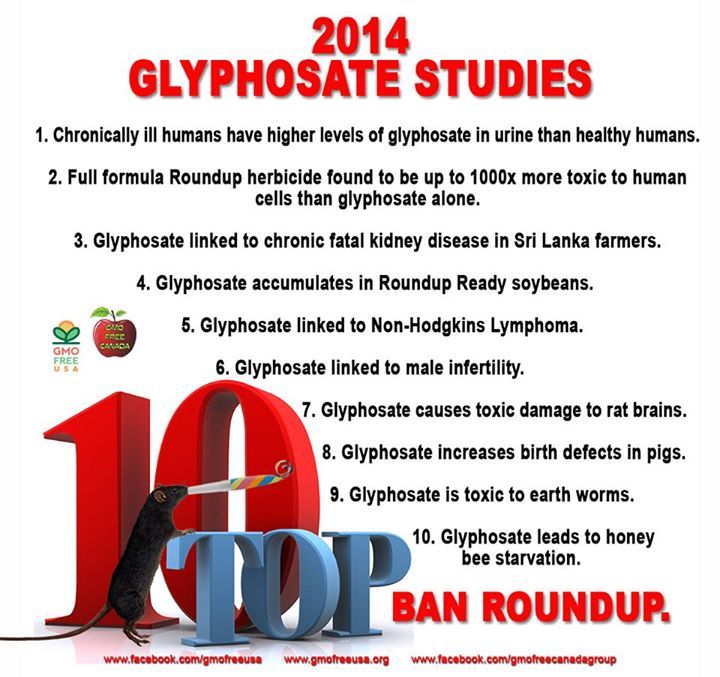
The IARC has provided scientific evaluations for more than 40 years, with “very broad involvement of the scientific community [ ] through participation in the Working Groups and service on the IARC Governing and Scientific Councils…” The IARC has earned the highest respect within the scientific cancer research community which relies on the IARC assessments of substances that pose cancer risks. The American Cancer Society affirms the high regard on its website listing the Known and Probable Human Carcinogens, it states:
“[The] lists of substances and exposures that are known or suspected to cause cancer have been developed by two highly respected agencies – the International Agency for Research on Cancer (IARC) and the US National Toxicology Program (NTP)… The IARC and NTP act independently but have studied many of the same agents, so many known or suspected carcinogens appear on both lists. But because an agent appears on one and not on the other does not necessarily mean there is a controversy, as one agency may not have evaluated it… the most widely used system for classifying carcinogens comes from the IARC.”
The IARC Working Groups rely heavily on independent studies that conform to “reproducibility” a primary principle of the scientific method requiring transparency, the sharing of original data and analytical codes, to ensure that the data and analyses are trustworthy, and the results independently reproducible. (Science Translational Medicine, 2016) This scientifically rigorous process is met mostly by independent studies, as most industry generated studies do not share the data. The deliberative process of the IARC panels is transparent and panelists are free from conflicts of interest. (Read “IARC Monographs: 40 Years of Evaluating Carcinogenic Hazards to Humans,” signed by 100 scientists, published by Environmental Health Perspectives, June 2015)
We cite the following scientific reports and independent scientists’ consensus statements in support of the IARC determination.
- In 2013, a report by the German Medical Laboratory Bremen found glyphosate residues in the urine of people in 18 European countries.
- A review of the evidence found that: “Contrary to the current widely-held misconception that glyphosate is relatively harmless to humans, the available evidence shows that glyphosate may rather be the most important factor in the development of multiple chronic diseases and conditions that have become prevalent in Westernized societies…” (Glyphosate’s Suppression of Cytochrome P450 Enzymes and Amino Acid Biosynthesis by the Gut Microbiome: Pathways to Modern Diseases,” by Anthony Samsel and Stephanie Seneff, Entropy (2013)
- In 2014, Moms Across America reported the results of glyphosate laboratory tests in the U.S. The herbicide was found in urine at levels 10 times higher than in Europe. And it found glyphosate in breast milk at levels 760 to 1600 times higher than the European Drinking Water Directive allows.
- IARC Monographs: 40 Years Evaluating Carcinogenic Hazards to Humans. Commentary signed by 100 scientists. , Environmental Health Perspectives (June 2015)
- Open letter: Review of the Carcinogenicity of Glyphosate by EFSA and AfR, signed by 96 independent academic and government scientists. (November 2015)
- A report by the Institute of Science in Society (2015) accuses Monsanto of concealing glyphosate’s carinogenic potential “claiming it is ‘safe’ and perpetuating many falsehoods about to promote its ubiquitous and liberal use.”
- In 2016, Microbe Inotech Laboratories found glyphosate in childhood vaccines: the MMR (measles, mumps, rubella) vaccine contained glyphosate at 25 times higher levels than other vaccines.
- A Consensus Statement published in Environmental Health (2016) drew on the emerging science relevant to the safety risks posed by glyphosate-based herbicides (GBH). The statement was authored by 14 scientists.
- A report in the International Journal of Environmental Research & Public Health (2016) calls for a U.S. regulatory review of glyphosate.
- Carcinogenicity of Glyphosate: A Systematic Review of the Available Evidence by Christorpher J. Portier, November 2016
Since FDA’s approval process for genetically engineered food products was radically curtailed in 1992, a body of scientific evidence shows that GE food products and those who ingest them contain harmful residues of pesticides that are embedded in GE plants’ DNA. A newly released report (2016) by Food Democracy Now provides details about the documented findings of Anresco Laboratories, an independent, FDA-registered food testing laboratory that provides comprehensive microbiological, chemical, pesticide residue, and nutritional analyses.
The lab documented alarming residue levels of glyphosate in America’s most popular food brands — especially in cereals eaten by young children. Glyphosate was found in human urine, breast milk, and blood. (An itemized Food product chart indicates estimated level of glyphosate residue in each. Cheerios tips the scale with the highest glyphosate residue — 1,125.2 ppb (parts per billion) (Read: Glyphosate: Unsafe on Any Plate, 2016)
Following the IARC review of glyphosate the European Parliament called for a complete ban on non-commercial public use of glyphosate and called for serious restrictions on agricultural use. A petition signed by more than 2 million people calls for a ban as well. Several European countries – France, Sweden, Italy and the Netherlands — rebelled against the European Commission which recommended relicensing glyphosate for 15 years. When that recommendation failed to be approved by the European Union, the Commission proposed a nine year extension – and it failed to gain approval as well. The vote for relicensing glyphosate was then postponed. This was a major set-back for Monsanto revenues from its Roundup branded glyphosate-based herbicide products is approximately $5 billion annually. In August 2016, the EU voted to limit the license for 18 months, until December 2017.
The US failed its responsibility to protect the health of the American public. Indeed, the agencies created to protect the public health, have colluded and even conspired with industry. The EPA seal of endorsement for the safety of glyphosate has been pivotal to the multi-billion dollar success of the GMO business which relies on Monsanto’s GE glyphosate-infused seeds and glyphosate sprayed crops.
In January 2017, lawyers for 50 plaintiffs filed a lawsuit in U.S. District Court
The case, filed in Northern California charges Monsanto with covering up the cancer risks from exposure to its herbicide Roundup. They have requested the court to unseal documents uncovered during the discovery phase, that Monsanto labeled “confidential.” The documents show the close interactions between Monsanto and EPA’s former top official, Jess Rowland, who chaired EPA’s Cancer Assessment Review Committee (CARC) that issued an internal report (Oct. 2015) contradicting IARC’s assessment, stating “glyphosate was “not likely to be carcinogenic to humans.” Rowland has been pivotal to Monsanto in its efforts to rebut the IARC assessment. His report was posted on EPA’s public website for three days when it was abruptly removed. (Reuters, May 2016)
- Was this an intentional action to provide Monsanto with a government document attesting to the safety of its “probably carcinogenic” product?
“The agency said the report was not final and that it should not have been posted, but Monsanto touted the report as a public affirmation of its safety claims for glyphosate. The company also brought a copy of the report to a May court hearing in the Roundup litigation as a counter point to the IARC cancer classification. Shortly after the CARC report was removed from the EPA website, Rowland left his 26-year career at the EPA.
Plaintiffs’ attorneys have asked to depose Rowland… the EPA has specifically refused the deposition request, saying it would “not clearly be in the interests of EPA” to allow attorneys to question Rowland about the cancer review and interactions with Monsanto.
According to the court filings… the documents show “it is clear that Monsanto enjoyed considerable influence within the EPA’s OPP, and was close with Mr. Rowland… The documentary evidence strongly suggests that Mr. Rowland’s primary goal was to serve the interests of Monsanto.” (Read more: Carey Gillam, The Huffington Post, January 2017)

Monsanto’s war against the IARC & honest science
Monsanto and its army of academic lackeys and “hit squads” embarked on an aggressive trashing campaign aimed at invalidating the IARC determination by discrediting the IARC and the scientists of the Working Group. Monsanto impugned the authority of the IARC, its motives, and its credibility. An orchestrated barrage of defamatory lies and invectives were dispatched to the media and government officials maligning the IARC: “IARC’s work is not a study…its decision is irresponsible, and it has the potential to cause confusion…contradicts regulatory findings that glyphosate is safe.” Monsanto’s chief technology officer characterized the IARC “probable carcinogenic” determination as “junk science.”
This is Monsanto’s long-standing pit bull tactic for dealing with scientists who publish scientific reports unfavorable to its business interests. Monsanto’s V-P for Global Strategy, Scott Partridge wrote:
“[IARC is] a non-governmental French-based group” IARC has no regulatory authority and its decision does not impact glyphosate’s label, current registration or use…its findings were called “controversial… IARC is creating needlessly misinformed debate, undermining public policy, and harming affected industries…the IARC group selected a subset of information for review, including reports that were self-authored by IARC’s own members, and studies that had been soundly discredited by other scientists. The publications and tactics of IARC and its members about glyphosate raise many serious questions about their purposes and processes.” (Monsanto website)
100 scientists attest to IARC ‘s proven record of sound scientific judgement:
“For more than four decades the IARC Monograph Programme has provided evaluations of cancer hazards to humans from many different exposures and agents. These are often the first evaluations of new and emerging threats to public health and, consequently, are subject to intense scrutiny. Although these evaluations are widely respected and used by many organizations, institutions, companies, and government agencies to improve the public’s health, IARC has recently been subject to criticism over conclusions on specific agents, the process that leads to such conclusions, and membership of the Working Groups. Debate and criticism facilitate self-correction and a check on the validity in science. We are concerned, however, that the criticisms expressed by a vocal minority regarding the evaluations of a few agents may promote the denigration of a process that has served the public and public health well for many decades for reasons that are not supported by data.
There has been very broad involvement of the scientific community in the IARC Monograph Programme through participation in the Working Groups and service on the IARC Governing and Scientific Councils and ad hoc Advisory Board for the Monograph Programme.
Many exposures that IARC has evaluated have also been independently evaluated by other institutions, such as the U.S. National Toxicology Program; National Academy of Sciences; the Nordic Expert Group for Criteria Documentation of Health Risks from Chemicals; Institute of Occupational Medicine; World Cancer Research Fund/American Institute for Cancer Research (WCRF/AICR) Expert Reports….
Assessments from these groups typically come to conclusions similar to those from IARC.
This further indicates broad agreement within the scientific community regarding evidence on carcinogenicity in the scientific literature and expands the number of scientists who do not have a “vested interest” but who have generally agreed with those conclusions.” (Environmental Health Perspectives, June 2015) [emphasis added]
In October 2015, EFSA (the European Union’s Food and Safety authority) issued an “alternative version” of a glyphosate review supporting Monsanto’s safety claim. The credibility of EFSA, however, is severely damaged by continued revelations of its scientific panel members’ financial conflicts of interest. A non-profit research and advocacy group, Corporate Europe Observatory (CEO) uncovered evidence showing that more than half of the 209 scientists on EFSA panels have direct or indirect ties with the industries they are meant to regulate. Another CEO investigative report (2014) found that two thirds (67%) of the scientists in the European Commission who drafted opinions on controversial toxic substances had direct and indirect links with affected industries.
EU Commission, EFSA, BFR, ILSI — a “cesspool of corruption”
To gain an understanding of the intricate web of interlocking European Union agencies and commissions whose responsibility is to assess the safety of various chemicals for use within the entire European Union, read: “The Incredibele Brussels Glyphosate Sheep Dip by F. William Engdahl, (2016); Arthur Nelsen, the UK Guardian (2016); Corporate Europe Observatory.
In 2012, the European Parliament suspended EFSA’s funding for six months because of conflicts of interest allegations involving collusion with a corporate lobbying group – International Life Sciences Institute (ILSI) members on the board of EFSA committees. “The dispute saw the resignation of the chair of the Efsa management board, as well as Moretto standing down as a member of the Efsa pesticides panel, for failing to declare links with the industry and ILSI. An advisory position held by Boobis at Efsa was discontinued in 2012.”
The EFSA review drew on an assessment by BFR, the German Federal Institute for Risk Assessment, which had concluded that there was “no validated or significant relationship” between exposure to glyphosate and an increased risk of cancer. However, an investigation by Test Biotech (2012) a German NGO, uncovered blatant conflicts of interest — one third of BFR members are employed by the GMO/ pesticide companies – Bayer, Syngenta, BASF. Those conflicts undermined the credibility of its assessments.
Open letter compared the review of carcinogenicity of Glyphosate by EFSA and BfR
The letter, dated November 2015, was signed by 96 independent academic and government scientists from 25 countries, who called on the European Commission “to disregard the flawed EFSA finding on glyphosate” whose conclusions disregarded seven positive mouse studies that showed cancerous tumors. The scientists called for a “transparent, open and credible review of the scientific literature” citing the fact that:
“many of the aspects of transparency do not exist for [EFSA Renewal Assessment Report] or the BfR Addendum. For example, citations for almost all of the references, even those from the open scientific literature, have been redacted from the document.”
“The ability to objectively evaluate the findings of a scientific report requires a complete list of the cited supporting evidence. As another example, there are no authors or contributors listed for either document, a requirement for publication in virtually all scientific journals. This is in direct contrast to the IARC WG evaluation listing all authors, all publications and public disclosure of pertinent conflicts of interest prior to the WG meeting.”
We strongly object to the almost non-existent weight given to studies from the literature by the BfR and the strong reliance on non-publicly available data in a limited set of assays that define the minimum data necessary for the approval of a pesticide. We believe that the IARC WG evaluation of probably carcinogenic to humans accurately reflects the results of the published scientific literature on glyphosate and, on the face of it, the unpublished studies to which the BfR refers. Conversely, the BfR evaluation, and consequently the EFSA evaluation, do not reflect the available science.”
EFSA and BfR relied on unpublished industry tests—most of which are under a proprietary seal of secrecy – and therefore, inaccessible for independent scientific review – the IARC working groups examine only vetted, peer-reviewed research accessible for independent scientific review. The signatories to the letter included specialists in cancer, epidemiology and public health at major universities and cancer research institutes around the world.

The lead signatory to the Open Letter was Dr. Christopher Portier, an internationally recognized expert in the design, analysis, and interpretation of environmental health data. He contributed to the development of national and international risk assessment guidelines. Dr. Portier was the Director of the US National Center for Environmental Health (NIEH) at the Center for Disease Control (CDC); and former associate director of the US National Toxicology Program; and is the recipient of numerous scientific awards including the International Society for Risk Analysis (2013). He is senior collaborating scientist, Environmental Defense Fund.
Reuters reported that when questioned about the source of the studies which were the basis for EFSA’s determination, an EFSA spokesperson claimed: “The status of a study — e.g. independent or industry-sponsored — is irrelevant to the assessment if the study is designed, carried out and reported well.” Is this not a clear contradiction of EFSA’s “comprehensive policy on independence?” (European, WHO agencies in war of words over glyphosate findings, Reuters, April 2016)
In an interview, a year later, Dr. Kurt Straif, defended the IARC determination which, he explained,
“was made on the basis of three “strings of evidence“: “clear evidence of cancer in experimental animals, limited evidence for cancer for humans from real-world exposures, of exposed farmers, and also strong evidence that it can damage the genes from any kind of other toxicological studies.”
“There is not a single example of IARC being wrong, showing something is a probable carcinogen and then later it is proven not to be.” (EcoWatch, 2016)
In 2016, Monsanto escalated the war against the IARC & individual scientists
Monsanto embarked on a campaign aimed not only at trashing the reputation of the IARC; it used its political muscle to bring powerful congressional committees into the fray — House Science Committee, Oversight and Government Reform Committee, and the Appropriations Subcommittee — to threaten withdrawal of U.S. funding for the IARC (which involves a relatively modest NIH grant). But also to threaten government agencies and to eliminate all interaction between US agency scientists with the IARC. And as is this company’s long-standing modus operandi, Monsanto embarked on a vicious strategy of intimidation and harassment against the individual scientists who had provided any information to the IARC. Reuters reported that:
“Monsanto has filed Freedom of Information Act requests against U.S. scientists involved in the IARC working group on glyphosate. The company has issued subpoenas seeking records, as well. Other law firms and interest groups claiming a stake in the debate have filed various record requests as well against the National Institute of Health and EPA.
“U.S. scientists who were members of IARC’s working group on glyphosate are now drawing the wrath of Congress. The House Science Committee also questions the relationship between EPA and Christopher Portier, a retired official from the Centers of Disease Control who works as a consultant for the Environmental Defense Fund and was listed as an IARC adviser on the glyphosate report. Portier exchanged emails with top EPA officials about EPA’s own Cancer Assessment Review Committee report that declared glyphosate likely was not carcinogenic. EPA posted that report briefly, then pulled it off its website.” (U.S. Lawmakers to Investigate Funding of WHO Cancer Agency, Reuters October 2016)
Monsanto’s media and academic “hit squads” have been working overtime to distort the truth and misrepresent the scientific facts and slander the IARC. Professor emeritus Bruce Chassy, a major paid “foot soldier” for Monsanto since 2011 in its battle against honest regulators and independent scientists. (Read more here, here, here, and here) He penned a screed in The Hill (2016) stating:
“a clear anti-industry bias seems to be choking the credibility of the IARC agency that has been accused of “quackery”…has been widely criticized for its shoddy science and plagued by questions of bias.. Because of the IARC’s flawed assessment and its unprecedented political lobbying, glyphosate’s re-approval is now threatened in Europe, and the U.S. Environmental Protection Agency has delayed what should have been an easy re-approval. Losing glyphosate would be a massive blow to American farmers, consumers and the agricultural economy.”
An example of a media hatchet job that Joe McCarthy would approve is one penned by Julie Kelly “the Prognosis for a Controversial Cancer Agency Looks Terminal” published by the National Review.
“IARC now faces congressional inquiries, legal challenges, and harsh criticism from the scientific community that are shredding the agency’s credibility and threatening its future. The Lyon, France–based group… has received millions in U.S. tax dollars, funding that is now being questioned by top lawmakers on Capitol Hill…
Congress is also investigating whether IARC is colluding with officials at the EPA to advance a political agenda rather than sound science…The increasing amount of evidence depicting the close ties between EPA officials, Christopher Portier, and the IARC study of glyphosate show that there are activists working both inside and outside the agency to derail this process.” …Another agency seems to be playing political games about glyphosate [is] the EPA. Lamar Smith is seeking testimony from three EPA employees tied to the IARC working group…
Questions about a corrupt process also began to emerge; the man who pushed for the glyphosate review, Christopher Portier, is an environmental activist…IARC working-group members include scientists from American public universities and EPA employees who are required to comply with FOIA.
A report by the Institute of Science in Society (2015) argued that Monsanto and the EPA have known — since the 1980s — about the carcinogenic potential of glyphosate from animal experiments.
“Glyphosate and its residues have heavily contaminated air, soil, and water worldwide, constituting a major increase in pesticide burden on public health. It is to be found not only generally in human and livestock urine through exposure in food and feed (as well as in drinking water, and through inhalation from the air and absorption through the skin), but also in all livestock tissues tested and in mother’s milk, contradicting all the claims of the manufacturer that glyphosate does not accumulate in soil or leach into water, and that it does not bio-accumulate in tissues.” (Dr. Mae-Wan Ho and Prof. Peter T. Saunders Institute of Science in Society, 2015)
Evidence shows glyphosate to be an endocrine disruptor
For more than twenty years, researchers have shown that exposure to some chemicals that were previously considered safe, can alter hormonal action in the body. Evidence that endocrine disrupting chemicals have the potential harm to human reproductive capability were ignored by the FDA. A growing body of peer-reviewed scientific evidence shows that in addition to posing a risk of cancer, glyphosate also acts as an endocrine disruptor at levels that the human population in America is routinely exposed to through the consumption of unlabeled GMO foods and foods that have been sprayed with glyphosate as a pre-harvest drying agent. The EPA estimates that 100,000 pounds of glyphosate is used annually in the production of US. oats, which comprises close to a third of Monsanto’s $15 billion in annual revenues from glyphosate-based products.
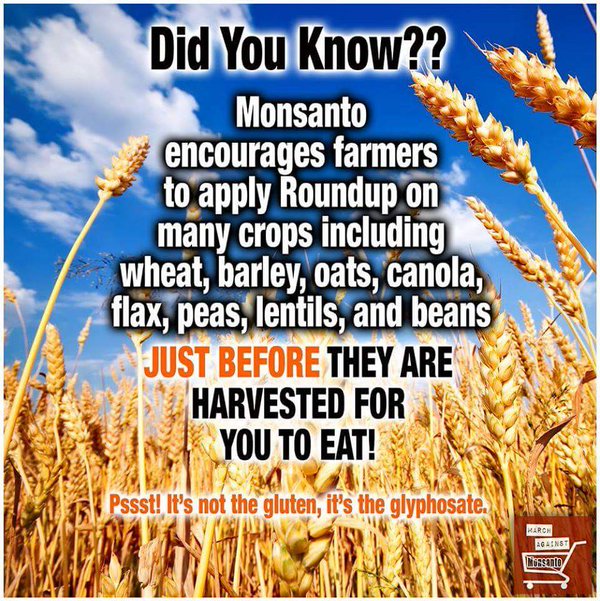 Monsanto’s continues to exert undue influence in setting U.S. GMO policies:
Monsanto’s continues to exert undue influence in setting U.S. GMO policies:
- For decades FDA exempted glyphosate from its annual testing of foods for residues of many types of pesticides.
- In 2013, Monsanto requested and received approval for higher pesticide residue tolerance levels for many foods.
- Monsanto and U.S. regulators claim that glyphosate levels in food are too low to cause any health problems in humans. But such assurances are meaningless without the government actually measuring glyphosate levels routinely as it does with other pesticides.
- A report (2016) by the General Accountability Office (GAO) recommended enhanced oversight of GE crops to ascertain the impact of unintended consequences of mixing GE crops with other crops. GAO criticized FDA’s limited disclosed of information to the public:
“FDA does not post developer submissions, including the safety and nutritional assessments of the GE crop submitted and the supporting data, on its website. In addition, these officials said the agency does not post information on consultations that were withdrawn before finalization or the reasons they were withdrawn, including any FDA concerns.”
“[Finally] in February of this year [ ] the agency said it would start some glyphosate residue analysis. That came after many independent researchers started conducting their own testing and found glyphosate in an array of food products, including flour, cereal, and oatmeal.
“The FDA which is quietly starting to test certain foods for residues of a weed killing chemical linked to cancer, has found the residues in a variety of oat products, including plain and flavored oat cereals for babies.” Carey Gillam, The Huffington Post (Sept. 30, 2016)
Real World Glyphosate Exposure at Detected Levels
To calculate real world exposure levels from glyphosate contamination in our food, consider the Cheerios’ results, since they’re the highest and are also regularly consumed by children, a chemically vulnerable population. For a 1-year old child, at roughly 20 pounds (9 kg), General Mills recommends a serving size of 16 grams or .56 ounces.Based on OLD SCIENCE: Acceptable Daily Intake (ADI) set by government regulators: 1.75 milligrams / kilogram of bodyweight / per day (1.75 mg / kg bw / day) Daily Intake from Cheerios (DI) based on 1 serving of 16 grams containing 0.018 mg glyphosate equals 0.002 mg /kg bw/day for a 20lb (9kg) child.
NEW SCIENCE says that harm may happen when you eat glyphosate at ONLY 0.001 mg/kg bw/day (1,750 times LOWER than what the EPA at the moment says is safe.) So, New Science shows that a 20lb (9kg) child can ONLY safely eat 0.001 mg x 9kg = 0.009mg glyphosate in a day. Thus, ingesting a recommended serving of Cheerios (16 grams or .56 ounces) for a 20-pound (9kg) child means exposure to 0.018 mg of glyphosate per day from Cheerios alone.
This is nearly double the level that is potentially harmful to human health and it is important to note that a 1-year old child is likely to be exposed to many other sources of glyphosate on a daily basis. (Food Democracy Now. Report. Glyphosate: Unsafe on Any Plate, 2016)
Concerns over use of glyphosate risks: A Consensus Statement (2016)
The statement was authored by 14 independent scientists based on the emerging science relevant attesting to the safety risks posed by glyphosate-based herbicides (GBH), the most widely used being Monsanto’s Roundup. Credible scientists agree that the effects from very low-doses of endocrine disruptors cannot be predicted from high-dose studies. New understanding about the cumulative effects of exposure to pesticides render EPA’s standard rule of toxicology — “dose makes the poison” — obsolete and misleading.
“Since the late 1970s, the volume of glyphosate-based herbicides (GBHs) applied has increased approximately 100-fold. Further increases…are likely due to more and higher rates of application in response to the widespread emergence of glyphosate-resistant weeds and new, pre-harvest, dessicant use patterns. Initial industry toxicity testing suggested that GBHs posed relatively low risks to non-target species, including mammals, led regulatory authorities worldwide to set high acceptable exposure limits.
… Animal and epidemiology studies published in the last decade, however, point to the need for a fresh look at glyphosate toxicity. In response to changing GBH use patterns and advances in scientific understanding of their potential hazards, we have produced a Statement of Concern drawing on emerging science relevant to the safety of GBHs. Our Statement of Concern considers current published literature describing GBH uses, mechanisms of action, toxicity in laboratory animals, and epidemiological studies. It also examines the derivation of current human safety standards.
“Collectively, studies from laboratory animals, human populations, and domesticated animals suggest that current levels of exposure to GBHs can induce adverse health outcomes. Many of these effects would likely not be detected in experiments adhering to traditional toxicology test guidelines promulgated by pesticide-regulatory authorities.”
“… concerns have been raised about the toxicity of herbicide mixtures, because current data suggest that chemicals in combination can have effects that are not predicted from tests of single compounds. GBHs themselves are chemical mixtures; in addition to the inclusion of glyphosate (the active ingredient), these herbicides include adjuvants such as surfactants, which can make GBH-product formulations more toxic than glyphosate alone.We conclude that: (1) GBHs are the most heavily applied herbicide in the world and usage continues to rise; (2) Worldwide, GBHs often contaminate drinking water sources, precipitation, and air, especially in agricultural regions; (3) The half-life of glyphosate in water and soil is longer than previously recognized; (4) Glyphosate and its metabolites are widely present in the global soybean supply; (5) Human exposures to GBHs are rising; (6) Glyphosate is now authoritatively classified as a probable human carcinogen; (7) Regulatory estimates of tolerable daily intakes for glyphosate in the United States and European Union are based on outdated science.
“We offer a series of recommendations related to the need for new investments in epidemiological studies, biomonitoring, and toxicology studies that draw on the principles of endocrinology to determine whether the effects of GBHs are due to endocrine disrupting activities. We suggest that common commercial formulations of GBHs should be prioritized for inclusion in government-led toxicology testing programs such as the U.S. National Toxicology Program, as well as for biomonitoring as conducted by the U.S. Centers for Disease Control and Prevention.” (Environmental Health, February, 2016)
In 2016, Scientists call for US regulatory review of glyphosate
While glyphosate is the primary chemical in Roundup, the formulation contains additional poisonous ingredients called “adjuvants” or “inerts” or “co-formulants” which in combination increase the toxicity of Roundup. A report in the International Journal of Environmental Research & Public Health (2016) warns that widely used “co-formulants in glyphosate-based herbicides” pose serious health problems:
“Reproductive health is influenced by environmental toxicants, including pesticides. The declared active ingredients (dAI) of pesticide formulations are not applied in their isolated form in agricultural use. Other substances (co-formulants) are also added, in order to modify the physico-chemical properties or to improve penetration or stability of the dAIs. The identity of the co-formulants (declared as inert) is generally kept confidential. Moreover, they are not used in medium or long term in vivotoxicity tests of pesticides on mammals for the establishment of their acceptable daily intake (ADI).
However, pesticide formulations and co-formulants alone have been demonstrated to be up to 1000 times more toxic to human cells than their dAI at 24 h exposure… mostly because they are sprayed on the 80% of genetically modified edible plants purposely designed to tolerate Roundup and, thus, contain its residues. When other pesticides are generally allowed in edible plants at levels around 0.01–0.1 ppb, glyphosate and its metabolite AMPA have among the highest maximum residue limits (MRL), with up to 500 ppm authorized in some genetically modified feed.
Up to now, endocrine-disrupting effects of pesticides have been studied mostly based on tests on their declared active ingredient. Here we report for the first time that, below their toxicity thresholds, the co-formulants, generally classified as inerts and kept confidential, act as endocrine-disrupting chemicals at levels up to several hundred times below the level at which the declared active ingredient demonstrates the same activity.
Glyphosate is never used alone, but always with its co-formulants. Thus the physiological effects of co-formulants should be more thoroughly tested and declared. We also recommend that the calculation of the ADI for pesticides should be based on toxicity tests of the commercial formulations rather than solely the declared active ingredient.”
(“Co-Formulants in Glyphosate-Based Herbicides Disrupt Aromatase Activity in Human Cells below Toxic Levels” International Journal of Environmental Research & Public Health, 2016)
Growing number of Roundup lawsuits
Concerns about the link between Monsanto’s GBH pesticide Roundup and lymphoma surfaced in March 2015, when the WHO’s IARC determined that glyphosate, the active ingredient in Roundup, is likely a cancer-causing agent. In particular, the IARC report links the side effects of Roundup to an increased risk of non-Hodgkin’s lymphoma. Farmers, landscapers, agricultural workers and others exposed to the weedkiller claim the manufacturer’s reckless promotion of Roundup increased its use and their exposure to its concealed health risks.
In April, 2016, cancer lawsuits were filed against Monsanto by John Sanders, a farmer who had sprayed RoundUp from a hand-held atomizer year-round and Frank Tanner, an owner of a landscaping business who sprayed between 50 and 70 gallons a year using a backpack or a 200-gallon drum rolled next to him. Both developed non-Hodgkin lymphoma, a blood cancer. (The Intercept, May 2016) The suits rely on scientific studies linking glyphosate to the following cancers: Non-Hodgkin lymphoma; bone cancer; colon cancer; kidney cancer; liver cancer; melanoma; pancreatic cancer; thyroid cancer.
In January 2017 more than 50 people in California are suing Monsanto
The same month a man in Georgia who developed mantle cell lymophoma from exposure to Roundup filed a lawsuit alleging Monsanto failed to warn about the cancer risk.
Read more: · Roundup Exposure Lawsuit Filed Over Lymphoma Diagnosis (12/29/2016)
- Non-Hodgkins Lymphoma Wrongful Death Lawsuit Filed Over Roundup Exposure (11/23/2016)
- Roundup Cancer Lawsuits to be Bifurcated in MDL, With General Causation Addressed First (11/21/2016)
- Roundup Injury Lawyers to Meet with MDL Judge Next Week (11/1/2016)
- Roundup Non-Hodgkins Lymphoma Lawsuit Permitted to Move Forward Against Monsanto (7/8/2016) –
- Read more at: About Lawsuits.com



